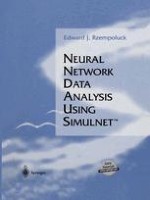Scope of this Text This text is intended to provide the reader with an introduction to the analysis of numeri cal data using neural networks. Neural networks as data analytic tools allow data to be analyzed in order to discover and model the functional relationships among the recorded variables. Such data may be empirical. It may originate in an experiment in which the values of one or more dependent variables are recorded as one or more independent vari ables are manipulated. Alternatively, the data may be observational rather than empirical in nature, representing historical records of the behavior of some set of variables. An ex ample would be the values of a number of financial commodities, such as stocks or bonds. Finally, the data may originate in a computational model of some physical proc ess. Instead of recording variables of the physical process, the computer model could be run to generate an artificial analog of the physical data. Since data in virtually any native form can be expressed in numerical format, the scope of the analytical techniques and procedures that will be presented in this text is es sentially unlimited. Sources of data include research work in a range of disciplines as di verse as neuroscience, biomedicine, geophysics, psychology, sociology, archeology, eco nomics, and astrophysics. An often fruitful approach to data analysis involves the use of neural network func tions.
